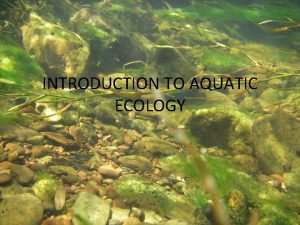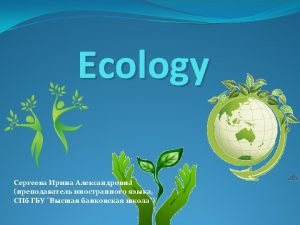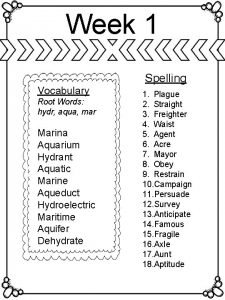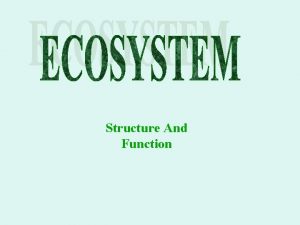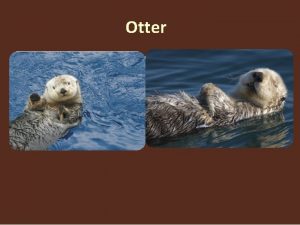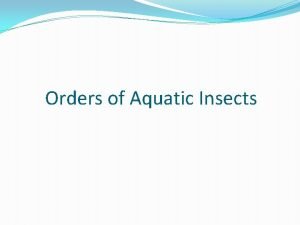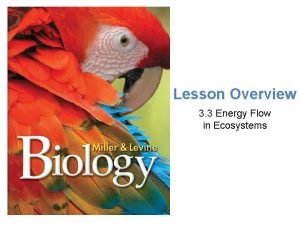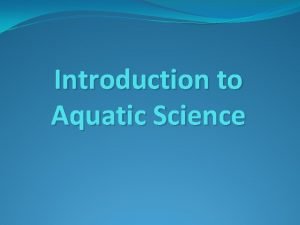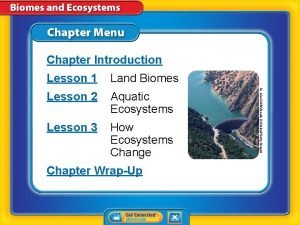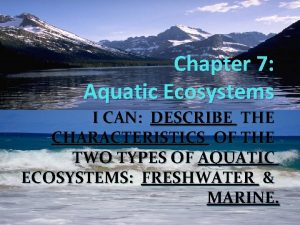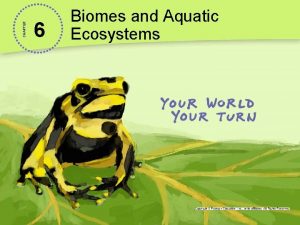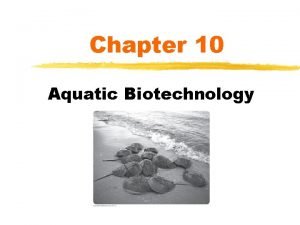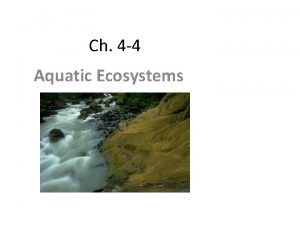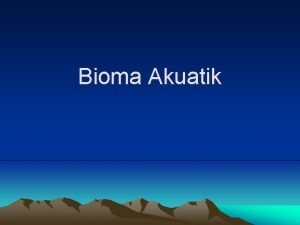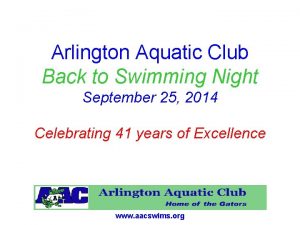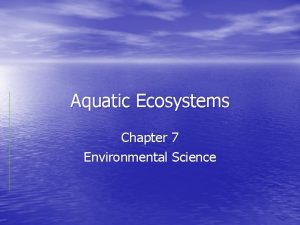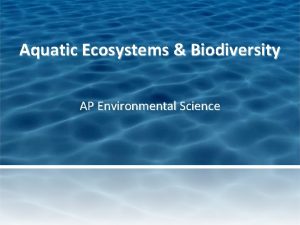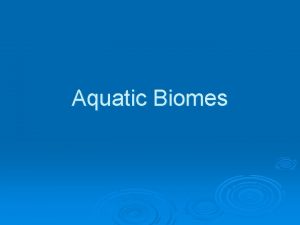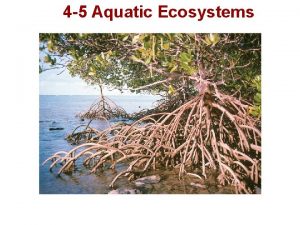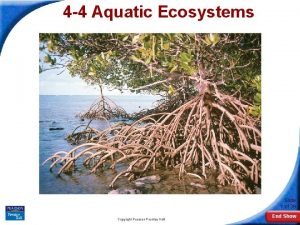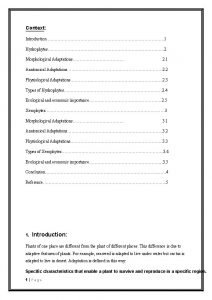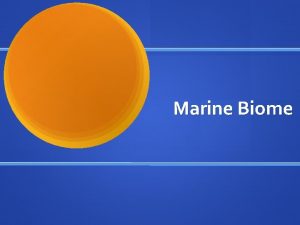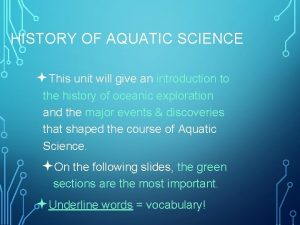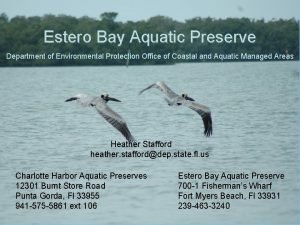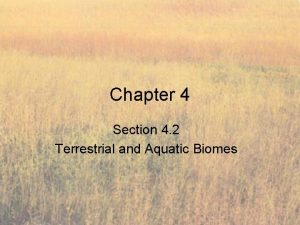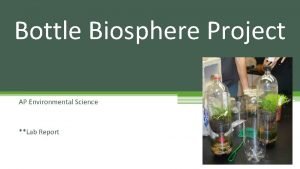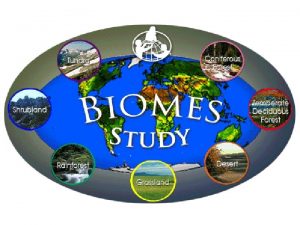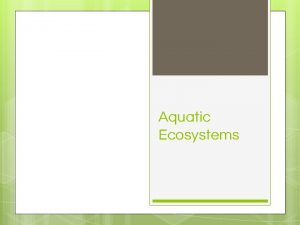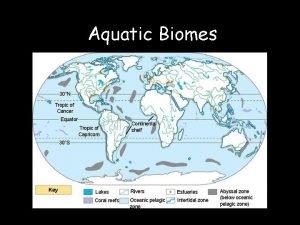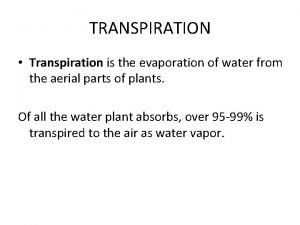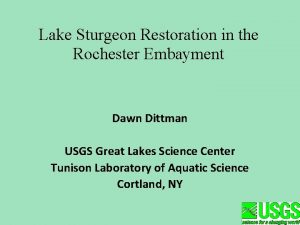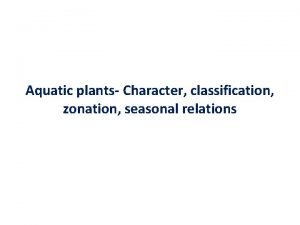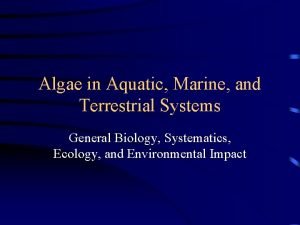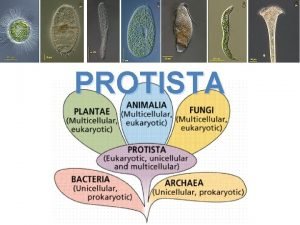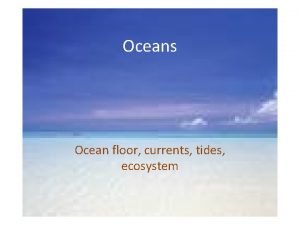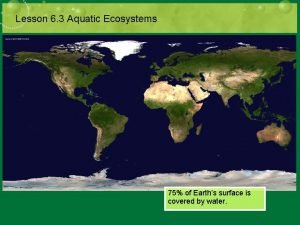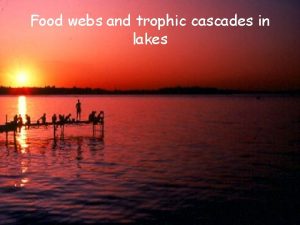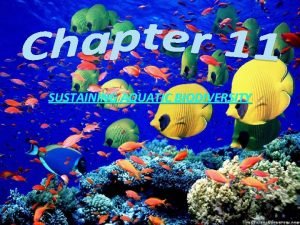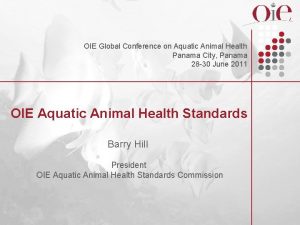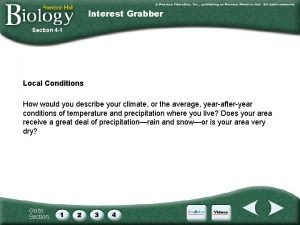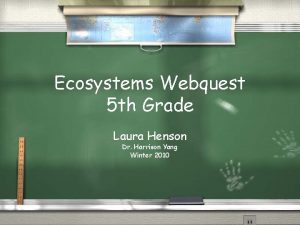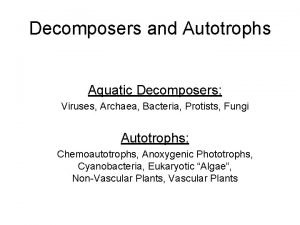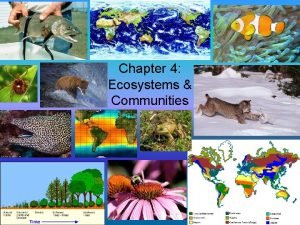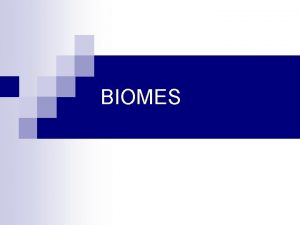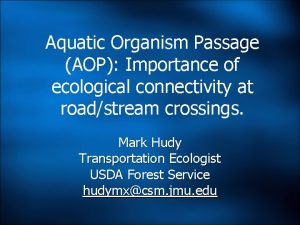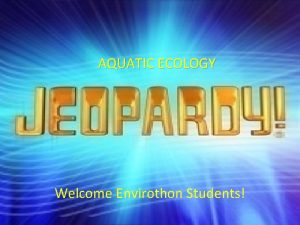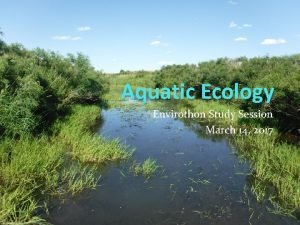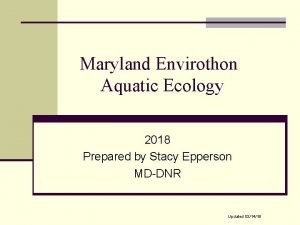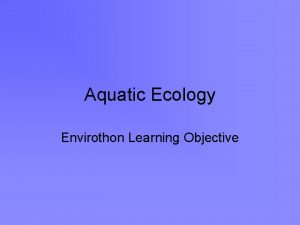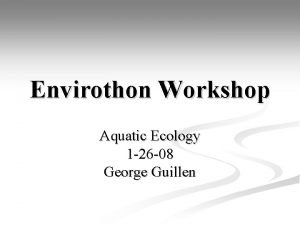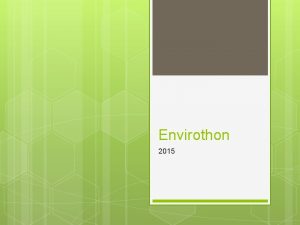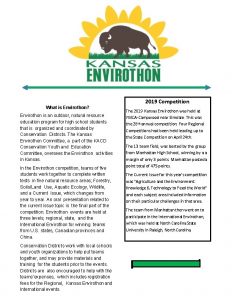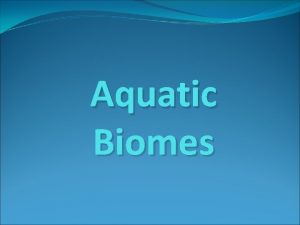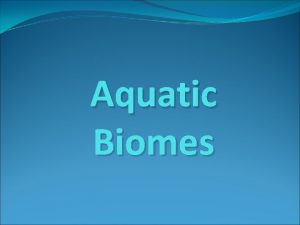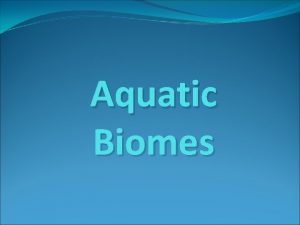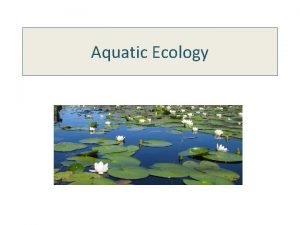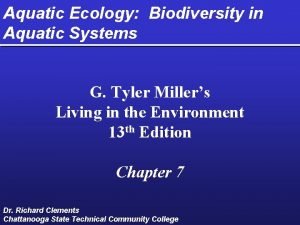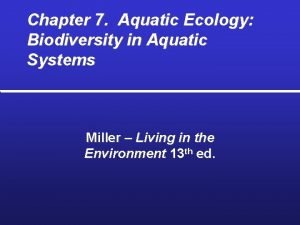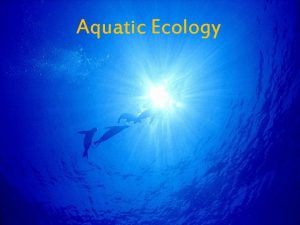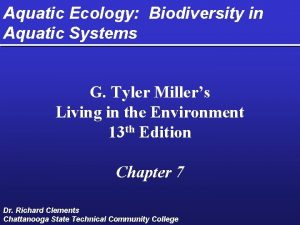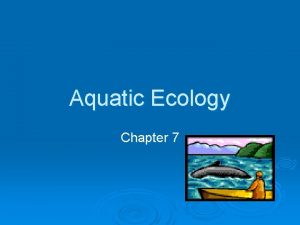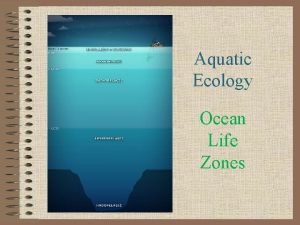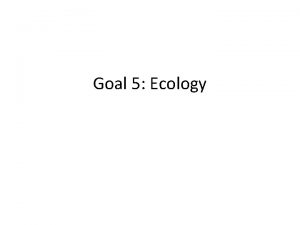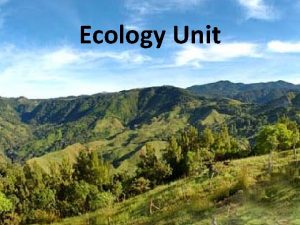Aquatic Ecology Envirothon Study Session March 14 2017































































- Slides: 63

Aquatic Ecology Envirothon Study Session March 14, 2017

Outline � � � � Watershed characteristics: watershed model/Stream Order/Aquifers Watershed Delineation Biological Zones, Lakes, Rivers and Wetlands Groundwater Drought/flood Water cycle/role in current topic Very Brief Intro to Water Quality Chemistry Healthy/ Unhealthy watersheds Macroinvertebrates/Fish ID- will have to id/know common fish ids, be able to know major groups of inverts and use a key Identify common, T&E, AIS species Sources of Pollution and prevention Uses of water/conservation Current Issue: Agricultural Soil and Water Conservation Stewardship


Hydrologic units (HUs) are defined watersheds at different spatial levels ranging from HU-2’s( big- Missouri River basin) to HU- 16 (small: roughly creek level). Here HUC 8’s are pictured. Their HUC (hydrologic unit code) is 8 - digits.

South Dakota River Basins

What is a Watershed? �All the land water features (surface water, but remember groundwater will be an input too)that drain to a specific location on a landscape. �Scale-dependent.

http: //www. miseagrant. umich. edu/lessons/files/2013/05/10 -728 -How-AWatershed-Works. jpg

headwaters confluence Stream Orders To know: headwaters, watershed boundary/divide, tributary, water table, channel, riparian area

Unconfining materials: Allows water through- sand, gravel Confining Materials: Clay, Shale To know: unconfined aquifer, recharge area, discharge area

Groundwater aquifers http: //www. waterrights. utah. gov/wellinfo/the is/hydrogeology_discussion. asp http: //www. ngwa. org/Fundamentals/Pages/G roundwater-Fact-Sheets. aspx

Watershed delineation


Identify outlet, which direction water will leave the watershed and nearby high points.

Delineate watershed by traveling perpendicular to contours. Connect high points that drain into the watershed of interest to create the drainage divide.

Biological Zones in Lakes Riparian zone AKA pelagic zone Aphotic zone To know: riparian zone, littoral zone, limnetic/pelagic zone, euphotic/photic zone, aphotic zone, benthic zone http: //www. lakeaccess. org/ecology/lakeecologyprim 9. html

River Zones “No man ever steps in the same river twice, for it's not the same river and he's not the same man. ”- Heraclitus Habitats- pools, riffles, runs Erosional/depositional zones

Floodplain, meander, oxbow lakes What are the implications of constraining a river in its banks for flood control, agriculture or development?


River geomorphology Different stream “types” by slope Evolution of erosional processes Downcutting or widening= unstable= erosion

Reservoirs � Sediment and nutrient traps, will age and have water quality problems � Flushing helps � http: //msaconline. com/

Drought and aquatic ecology �How does drought affect groundwater, lakes and rivers? �How would it affect water quality? �What happens after a drought is lifted? �Precipitation controls on water quantity and water quality �https: //water. usgs. gov/ogw/drought/ �https: //www. ncdc. noaa. gov/cag/time -series/us/39/1/pcp/ytd/12/18952015? base_prd=true&firstbaseyear=19 01&lastbaseyear=2000&trend=true&tr end_base=10&firsttrendyear=1895&las ttrendyear=2015

Water Chemistry 101 �Productive lakes – natural and due to nutrient addition, dissolved oxygen �p. H- can be too high or low for aquatic life, p. H of 5 -9 generally safe �Sediment �Bacteria: E Coli �Fish chemistry- mercury �Many possible chemicals to test for ( arsenic, cadmium fairly common but not routinely tested for)

Water Chemistry 101 Biological health � Overly productive lakes have algae that grow, bloom and die can result in crashes in dissolved oxygen that impact fish and aquatic life � Lakes naturally progress in eutrophication � Reservoirs especially fill with sediment, age and become eutrophic. � Inputs of nutrients ( N, P) accelerate algae growth � Temperature affects DO- warm water holds less oxygen. � Daily cycles(photosynthesize during the day, respire at night) and seasonal cycles(algae grow, bloom and die) and water temperature � Wind especially in South Dakota is an important control on the algae- wind causes turbidity, reducing light available for algae growth � Hot clear days in shallow lakes with no wind= recipe for algae bloom � Anoxia- when the bottom lake layer becomes oxygen-depleted can release inorganic phosphorus bound to the sediment= a vicious cycle where more phosphorus enters the water column, called internal loading � https: //water. usgs. gov/edu/dissolvedoxygen. html


Dissolved oxygen � How and when waters mix is important � Wind plays a role in mixing SD’s shallow lakes � Oxygen will be high if measured at the right times during an algae bloom, but will crash when the bloom dies Classical model: � Anoxic ( low to zero oxygen) layer can form on bottom forms when lake stratifies

Eutrophication and Oxygen � Simplified version focuses on eutrophication, in truth in SD very few nutrients need to be added to cause a bloom other conditions such as temperature, lack of mixing become important. Many of our lakes are hypereutrophic already. � What about other cycles in lakes- carbon cycle, nitrogen cycle?

Harmful Algal Blooms http: //oceanservice. noaa. gov/hazards/hab/ https: //www. epa. gov/nutrientpollution/harmful-algal-blooms

Other nutrient effects, the Dead Zone


River Continuum Concept �Considers a river over its whole length �Gradient (slope) decreases downstream �Shifts energy, nutrients from upstream to downstream. �Species also change from up to downstream. �Explains why headwaters are cool, fast-moving, high gradient, low nutrient and why large rivers are turbid, slow, laden with nutrients and sediment. http: //www. dnr. state. mn. us/whaf/key-concepts/rcc. html

Watershed health From EPA: A healthy watershed has the structure and function in place to support healthy aquatic ecosystems. Key components of a healthy watershed include: • intact and functioning headwater streams, floodplains, riparian corridors, biotic refugia, instream habitat, and biotic communities; • natural vegetation in the landscape; and • hydrology, sediment transport, fluvial geomorphology, and disturbance regimes expected for its location. � From MN DNR, “In most cases, instead of having a threshold value (98. 6 body temperature), watershed health is measured by comparing the current condition with an estimate of how natural systems in that location would function if it was in optimal health. ” https: //www. epa. gov/sites/production/files/2015 -10/documents/faqs_healthy_watershed. pdf


Role of wetlands �Identified by hydric soils, wetland plants, periodic to permanent inundation. �Store sediment, nutrients, carbon �Wildlife and plant life �Water filtration; improves water quality �Army Corps of Engineers regulates any fill of wetlands �Prairie potholes’ role esp. https: //www. epa. gov/wetlands/whatfor breeding waterfowl wetland

Know basic food web structure in each of the zones. Be aware of physical and chemical cycles/states and how they interact with biology. What are light, CO 2, O 2 and nutrients doing in each of the zones?


Keys to Aquatic Animals �Know basic fish biology and adaptations to the environment �Be aware of the importance of macroinvertebrates, how the presence of groups can tell something about water quality, functional roles and be able to identify from a key. �Be able to identify fish using a key. Know common, sport, bait, AIS (Aquatic Invasive Species) and T&E species. �http: //www. dep. wv. gov/WWE/getinvolved/sos/macros/Pa ges/Aq. Inverts. aspx �http: //mrbdc. mnsu. edu/macroinvertebrates �http: //www. waterontheweb. org/

Macroinvertebrate functional roles�Shredders- feed on decaying organic matter (OM), leaves, twigs. Ex- scuds, stoneflies, caddisflies. Favor headwater streams. �Collectors/ filter feeders: feed on OM particles. Ex- black flies, riffle beetles, midges, mayflies, some caddisflies. All habitats. �Scrapers/Grazers : feed on algae. Ex- water pennies, mayflies, some caddisflies. Favors larger streams. �Predators- capture prey. All habitat types- dragonflies, damselflies, dobsonflies, alderflies, fishflies, aquatic beetles, stoneflies, spiders and water mites. Live in all habitats. �https: //www. water. wa. gov. au/__data/assets/pdf_file/0018/4527/ 12591. pdf �http: //www. lakegeorgeassociation. org/what-wedo/Education/Macroinvertebrates. htm

Macroinvertebrates �Pollution tolerance with some examples �Major groups (highlighted in yellow) with some examples �Basic body plan, features of groups �Be able to use a key to identify

Macroinvertebrates 1

Flatworms �Predators and collectors �Pollution tolerant �Soft unsegmented body, eyespots �Like standing or slow-moving water Annelids- Leeches and Aquatic Worms �Most are pollution tolerant �Segmented body, no eyespots �Leeches are parasites or predators �Aquatic worms are detritivores �Like standing or slow-moving water

Mollusks � Freshwater- bivalves and gastropods � Eggs, larva (veliger – swimming larva in some), adult � Body plan- mantle ( cavity for breathing and excretion), radula (in snails), nerve cords, foot � In freshwater species, a hard shell covers the body � Snail (Gastropod)= one shell, scraper � Clams and Mussels (Bivalve) = two shells, filter feeders, often burrow � Gilled snails have a high oxygen requirement, their presence indicates good water quality, � Other snails are pollution tolerant � Freshwater mussels can be pollution intolerant, clams may be quite tolerant.

Macroinvertebrates part 2

Arachnids � Spiders and water mites � Predators, water mites have parasitic phase � 4 pairs of jointed legs (adult) � Variable pollution tolerance Crustaceans � Exoskeleton, jointed legs, segmented body, antennae, mandible, maxillae � 2 pairs of antennae, more than 4 pairs of jointed legs (adult) � Egg, larva, adult � Crawl or swim � Detritivores or grazers � Somewhat pollution tolerant as a group � http: //www. enchantedlearning. com/subjects/inv ertebrates/crustacean/index. shtml

Insects �Arthropod �In adults: exoskeleton, three-part body: head, thorax, abdomen, three pairs of joined legs, compound eyes, two antennae �Life cycle: egg, larva, (pupa), adult �Larvae- to distinguish count tails and tail filaments, look for wing pads and abdominal gills; see Stroud Macro. Key for practice http: //www. enchantedlearning. com/subjects/insects/pr intouts. shtml

Insects parts � Legs, hooks, gill tufts, antennae, head, thorax, abdomen, segment, tails � Prolegs, filaments, wing pads

Diptera- True Fly �Larvae have head and mouth parts (distinguish from aquatic worms) �Soft fleshy skin, may have prolegs (fleshy stub) �Larvae don’t have jointed legs

Coleoptera- beetles �No wing pads on thorax, skin moderately hardened, no prominent structures on sides of abdomen �Diverse group

Odonata- dragonflies, damselflies �Wing pads on thorax, lower lip folded under body �Damselflies have 3 gills on end of abdomen �Dragonfly stout, damselfly slender

Plecoptera- Stoneflies � Long thin antennae, wing pads present, gills on bottom of thorax if gills are present, 2 claws on each leg, 2 tails on end of abdomen � Crawlers � Shredders and predators � Sensitive to pollution, presence indicates good water quality

Ephemeroptera- Mayflies �Wing pads on thorax, gills that are flat plates or filaments on tops or sides of abdomen segments, 1 claw on each leg, usually 3, sometimes 2 tails at end of abdomen �Ecologically and functionally diverse �Most are sensitive to pollution

Tricoptera- Caddisflies �Head and thorax have thickened skin, rest of body fleshy, antennae very short, no wing pads, pair of prolegs with 1 claw at end of abdomen �Most make cases to live in with silk �Ecologically diverse �Almost all are sensitive to pollution

Megaloptera- Dobsonflies �Head and thorax have hard thick skin, abdomen has soft thin skin, large chewing mouthparts that extend beyond head, no wingpads on thorax, 3 pairs of legs on thorax, 7 -8 pairs of filament on thorax �Ecologically diverse- crawlers, sprawlers or burrowers

Fish Anatomy- know parts

How does anatomy give clues into a fish species’ behavior, habitat preferences and lifestyle?

Fish Species �Know common game and bait fish, predators and filter feeders �Should be able to distinguish between families of fish and know general characteristics Pike family- Northern Pike, Muskellunge Perch Family- Walleye, yellow perch Minnow Family- common carp, silver carp, common shiner, fathead minnow Sunfish Family- large/smallmouth bass, bluegill, black crappie Etc, �For more information, see South Dakota’s Guide to Common Fishes, SD GFP Fishing Regulations : http: //gfp. sd. gov/fishingboating/rules-regs. aspx

Aquatic Invasive Species (AIS) http: //sdleastwanted. com/species/default. aspx Silver/Bighead/Grass Carp European Rudd Zebra and Quagga Mussels Asian Clam Rusty Crayfish Aquatic Invasive Plants (and algae): Curly Pondweed Didymo Flowering Rush Purple Loosestrife Brittle Naiad How can we prevent spreading AIS species? Be familiar with new laws- see GFP page.

Threatened & Endangered species � Pallid sturgeon and Topeka shiner are federally endangered fish � Birds such as piping plover, whooping crane and other threatened reptiles, amphibians and insects depend on aquatic habitats � Other state and federally threatened species here: https: //gfp. sd. gov/wildlife/threatened-endangered/threatened-species. aspx#KEY

Water pollution: point source or nonpoint source � Point Source: municipal/ industrial pollution, need permit to discharge(NPDES) � Nonpoint Source: Agriculture is leading cause of pollution ( soil and nutrients that wash into waterbodies) � Also urban runoff, silvicultural, construction, mining, habitat modification, other � Anything that can be done to slow or reduce runoff water entering a waterbody will help reduce nonpoint source pollution. � Runoff carries sediment and other pollutants and is most problematic during times of high precipitation or snowmelt. � In urban areas, hard surfaces like pavement contribute to runoff. � In agricultural and natural areas, bare ground contributes to runoff and to soil erosion. Slowing water and reducing runoff can be accomplished by planting or preserving vegetation along stream banks, maintaining healthy soil, and reducing disturbances in those areas. https: //www. epa. gov/nps/what-nonpoint-source

Current Issues / Agricultural Soil and Water Conservation Stewardship Critical area planting Filter strips Sediment Dam �Best management practices �Conservation programs �Public and private roles �Soil health related to water quality �Soil erosion �Land use planning

Water uses � Waters in South Dakota classified according to uses: Water supply, fish life propagation, immersion/limited contact recreation, irrigation, commercial and industry � 79% of SD stream miles and lake acres in 2016 did not meet all of their beneficial uses. � Consumptive uses remove water from the available supplies- irrigation, commercial. � Only 2. 5% of water is freshwater, 68. 7% is in glaciers, 30. 1% is in groundwater, �. 007% of all water on Earth is available in lakes, rivers and wetlands https: //water. usgs. gov/edu/

GIS is a fun and useful tool for doing conservation work with numerous applications

(Some) Important Rules, Regulations, and Agencies SD GFP: public lands, fishing and boating regs https: //gfp. sd. gov/fishing-boating/rules-regs. aspx Also some private land assistance South Dakota DENR: State standards for air and water quality, beneficial uses for waters of the state and total maximum daily loads for waters that do not meet uses https: //denr. sd. gov/lawsrulesindex. aspx Natural Resources Conservation Service (USDA): Conservation Programs to reduce erosion and nonpoint source pollution in the agriculture sector, drought information Environmental Protection Agency: Implements Clean Water Act, Safe Drinking Water Act https: //www. epa. gov/laws-regulations/summary-clean-water-act USGS: Collect, analyze and interpret water quality data

Questions? �Anine Rosse, Environmental Scientist, SD DENR Anine. Rosse@state. sd. us Dennis Skadsen, Watershed Coordinator, Day County Conservation District dennis. skadsen@sd. nacdnet. net
 Aquatic ecology definition
Aquatic ecology definition Anthem of poland
Anthem of poland Ecology study guide answers
Ecology study guide answers Chapter 3 section 1 community ecology answer key
Chapter 3 section 1 community ecology answer key Ecology is the study that helps to preserve
Ecology is the study that helps to preserve Hosp root word
Hosp root word Lesson outline lesson 2 aquatic ecosystems answer key
Lesson outline lesson 2 aquatic ecosystems answer key Structure of ecosystem
Structure of ecosystem Chapter 3 section 3 aquatic ecosystems
Chapter 3 section 3 aquatic ecosystems Otters are semi aquatic
Otters are semi aquatic Maylfies
Maylfies Aquatic food chain
Aquatic food chain What is aquatic science?
What is aquatic science? Tansely
Tansely Pryamid of biomass
Pryamid of biomass Connecting the concepts: aquatic biomes
Connecting the concepts: aquatic biomes Aquatic ecosystems webquest
Aquatic ecosystems webquest Chapter 6 biomes and aquatic ecosystems
Chapter 6 biomes and aquatic ecosystems List few criteria used to classify aquatic biomes
List few criteria used to classify aquatic biomes Chapter 3 lesson 3 biomes and aquatic ecosystems
Chapter 3 lesson 3 biomes and aquatic ecosystems Aquatic biotechnology
Aquatic biotechnology Section 4-4 aquatic ecosystems
Section 4-4 aquatic ecosystems Zona oseanik
Zona oseanik Sport fair arlington
Sport fair arlington Differences between aquatic and terrestrial ecosystems
Differences between aquatic and terrestrial ecosystems What factors describe aquatic ecosystems
What factors describe aquatic ecosystems Limestone ridges built by tiny animals
Limestone ridges built by tiny animals Aquatic biomes apes
Aquatic biomes apes Examples of aquatic biomes
Examples of aquatic biomes Section 4-4 aquatic ecosystems
Section 4-4 aquatic ecosystems 4-4 aquatic ecosystems
4-4 aquatic ecosystems Model aquatic health code
Model aquatic health code Terrestrial food production systems
Terrestrial food production systems Enumerate the morphological adaptations of hydrophytes
Enumerate the morphological adaptations of hydrophytes Chapter 7 aquatic ecosystems test answers
Chapter 7 aquatic ecosystems test answers Aquatic biomes examples
Aquatic biomes examples History of aquatic science
History of aquatic science Estero bay aquatic preserve
Estero bay aquatic preserve Aquatic biomes in canada
Aquatic biomes in canada Bottle biosphere
Bottle biosphere Biomes and aquatic ecosystems
Biomes and aquatic ecosystems The uppermost layer of an aquatic ecosystem
The uppermost layer of an aquatic ecosystem The main limiting factors in an aquatic biome are
The main limiting factors in an aquatic biome are Code.org minecraft aquatic
Code.org minecraft aquatic Stomatal transpiration
Stomatal transpiration Tunison laboratory of aquatic science
Tunison laboratory of aquatic science Aquatic plants classification
Aquatic plants classification Are protists terrestrial or aquatic
Are protists terrestrial or aquatic Marsilea aquatic equisetum
Marsilea aquatic equisetum What kingdom is photosynthetic aquatic and unicellular
What kingdom is photosynthetic aquatic and unicellular Most amazing ecosystems
Most amazing ecosystems Lesson 3: aquatic ecosystems
Lesson 3: aquatic ecosystems Lake ecosystem food web
Lake ecosystem food web Aquatic
Aquatic Oie aquatic manual
Oie aquatic manual Aquatic
Aquatic Interest grabber
Interest grabber National aquatic resources research and development agency
National aquatic resources research and development agency Ecosystem webquest
Ecosystem webquest Aquatic decomposers
Aquatic decomposers Aquatic
Aquatic Section 4-4 aquatic ecosystems
Section 4-4 aquatic ecosystems Is eubacteria terrestrial or aquatic
Is eubacteria terrestrial or aquatic Aquatic organism passage
Aquatic organism passage
